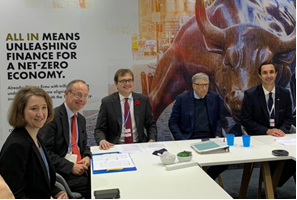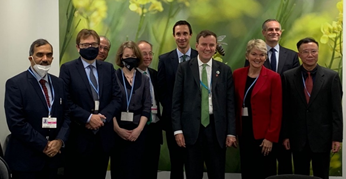
COP26 finally took place earlier this month in Glasgow with Mission Innovation (MI) members making sure clean energy innovation was firmly on the agenda throughout the fortnight. Those who attended said the busy, intense event left them feeling rewarded and inspired. For Mission Innovation (MI), COP26 was a resounding success.
Across COP26’s two-week programme, MI prominently featured at several high-profile events and announced four new missions. Below is a comprehensive review of MI’s role at COP26, and where we’re headed next. If you have a few minutes, you can also watch this MI video which was making the rounds throughout COP26.
To all those involved in MI’s efforts in Glasgow, congratulations! We are energised by your work – and we look forward to continued collaboration in the months and years ahead.
Glasgow Breakthroughs:
The Glasgow Breakthroughs were announced on 2 November at the World Leaders Summit. Glasgow Breakthroughs are the first step of the broader Breakthrough Agenda, a new commitment from nearly 50 countries to work across borders this decade to accelerate innovation and deployment of the clean technologies needed to keep the Paris Agreement’s goals within reach. At the summit’s Accelerating Clean Energy Innovation and Deployment event, Mission Innovation was highlighted as a key intergovernmental forum for clean energy innovation. MI’s missions on Clean Hydrogen, Green Powered Future and Net-Zero Industries were recognised as crucial initiatives to helping achieve Glasgow Breakthroughs focused on hydrogen, power and steel.
MI-CEM roundtable and handover event:
The MI and Clean Energy Ministerial Ministers of Steering Committee countries met on 4 November to discuss how to deliver on the ambitions of MI 2.0 and CEM 3.0.
Later the same day, the United States sponsored an event at which Mission Innovation recognised the U.S. as host for the next Mission Innovation Ministerial and CEM. (Watch the event here.)
Accompanied by Juan Carlos Jobet, Minister of Energy and Mining for Chile, which hosted the last Ministerial and CEM, U.S. Secretary of Energy Jennifer Granholm said she is looking forward to welcoming her peers to Pittsburgh in September 2022.
Patrick Child, Chair of the MI Steering Committee, said impactful international collaboration will continue to be critical to accelerating global clean energy transitions – and the key innovation platform supporting this will be Mission Innovation. Darren Miller, CEO of the Australian Renewable Energy Agency, stressed the importance of Mission Innovation to deliver action-focused public and private collaborations that drive down costs of clean energy solutions. Jennie Dodson, Head of the MI Secretariat, welcomed the U.S. as host of the first Ministerial of MI 2.0 and looked forward to demonstrating progress toward its ambitious vision.
Science and Innovation Day:
The flagship innovation event on COP26’s Science and Innovation Day was Accelerating Innovation: Cooperation for a Net-Zero Future, where Mission Innovation showcased our four new “Wave 2” Missions.
Our new Missions are:
- Carbon Dioxide Removal Mission: Launched 5 November at the U.S. Department of Energy’s Going Negative on Carbon Event by Secretary Granholm on behalf of the U.S., Khalid Abuleif Chief Negotiator for Climate Agreements on behalf of Saudi Arabia and Minister Jonathan Wilkinson on behalf of Canada. The Mission will advance carbon dioxide removal technologies to enable a net reduction of 100 million metric tons of CO2 per year globally by 2030. More here.
- Urban Transitions Mission: Launched 9 November at the Accelerating Innovation event by Frans Timmermans, Vice-President of the European Commission. This Mission – led by the European Commission, the Global Covenant of Mayors for Climate & Energy, and Joint Programming Initiative, Urban Europe – will demonstrate how large urban areas can successfully integrate energy end-use and supply sectors within the built environment, mobility, industry and energy sectors, providing reliable and affordable solutions by the end of this decade. More here.
- Net-Zero Industries Mission: Announced 9 November at the Accelerating Innovation event by Austrian Minister Leonore Gewessler. MI members recognise that heavy industries like steel, cement and chemicals require extremely high temperatures and use massive amounts of energy. MI members, led by Austria and Australia, are developing a mission to respond to this challenge. More here, with further details to come early 2022.
- Integrated Biorefineries Mission: Announced 9 November at the Leadership Group for Industry Transition Summit by Dr. Jitendra Singh, Minister Science and Technology India and Dilan Yeşilgöz, State Secretary for Economic Affairs and Climate Policy, Netherlands. Replacing fossil fuel-based fuels, chemicals and materials with sustainable bio-based alternatives from residues and wastes could reduce emissions from the transport and chemical sectors, providing a renewable alternative for hard-to-abate sectors and helping support rural jobs. To realise this potential, India and the Netherlands are leading the development of this Mission. More here, with further details to come in 2022.
“Mission Innovation is all about collaborating across borders and working together to innovate so we can tackle the climate crisis faster,” Secretary Granholm said. “These four new missions will turbo-charge key climate solutions and help grow clean energy worldwide, bringing with it unprecedented economic opportunities.”
Also at COP26, our “Wave 1” Missions, which were launched in June 2021, reported back on recent progress. Updates from Glasgow included:
- Clean Hydrogen Mission: Launched its discussion paper at Hydrogen Research, Development & Innovation: Global Priorities in Support of Clean Hydrogen Industry Development. The Hydrogen Mission also featured at the Hydrogen Transition Summit and at the UN Energy Compact showcase side event.
- Green Powered Future Mission: Launched its roadmap 9 November. The roadmap provides a 10-year pathway to reach the Mission’s goal of demonstrating the integration of up to 100 percent variable renewable energies in different power systems. The launch event featured key messages from committed countries and a panel discussion by business leaders and sector experts.
- Zero-Emission Shipping Mission: Launched its paper, The Pathway to 2030, 8 November at the Danish Pavilion. The accompanying session showcased broad political commitment and discussed key next steps, challenges and milestones. The Shipping Mission also featured at the Green Shipping Corridor: Launch of Clydebank Declaration Initiative event, where the Mission’s global initiative was discussed in the context of establishing green shipping corridors. The Mission also featured at an event on scaling up zero-emission fuels’ supply infrastructure.
Breakthrough Energy Partnership:
 Mission Innovation and Breakthrough Energy on 3 November announced an expanded partnership to drive investment that brings technologies to market.
Mission Innovation and Breakthrough Energy on 3 November announced an expanded partnership to drive investment that brings technologies to market.
“The only way the world can reach net-zero emissions by 2050 is if clean energy is made affordable and accessible for everyone – especially those in middle- and low-income countries,” said Bill Gates, Breakthrough’s founder. “Expanding Breakthrough Energy’s long-standing partnership with Mission Innovation will help move that vision closer to reality by increasing our focus areas and funding for the research, development, and demonstration of new innovations and climate solutions.”
Cooling Roadmap:
Beating the Heat: A Sustainable Cooling Handbook for Cities was launched 3 November by Mission Innovation, the Cool Coalition, UN Environment Programme, Rocky Mountain Institute, the Global Covenant of Mayors for Climate & Energy and the Clean Cooling Collaborative. The handbook offers planners an encyclopaedia of proven options to help cool cities, with 80 supporting case studies and examples.
